Inspired by my friend Debi, I’ve been trying to go to more WWII museums when I’m in other countries. It’s an event that was big enough that a huge number of places have them, and everyone has a unique perspective on the war and their nations’ context within it.
So when I learned that the US “national” WWII museum was in New Orleans, I was excited to spend a day checking it out. Now, in this particular case, a “national” museum is not the same thing as a “federal” museum. This isn’t a Smithsonian museum, or funded/run by the federal government in some other way. This is a private museum that got the “national” designation via an act of Congress.
That isn’t necessarily a bad thing. I’ve been to plenty of excellent private museums (one of which I might get around to writing about). Just keep it in the back of your mind for context.
Another piece of context: before expanding into WWII more generally, this museum started as a D-day Museum, and the D-day exhibit was where I started.
The tight focus of topic, and evident extensive time that this exhibit had had for refinement made for a pretty excellent exhibit. It was laid out to provide a ton of context about the landings, allowing anyone who knew WWII happened to get a grasp of what made D-day both a big deal and a challenge.
Mixing historical gear (uniforms, weapons, and vehicles) with video maps, recorded oral history accounts, and video with transcripts of strategy meetings made for an engaging and informative time.
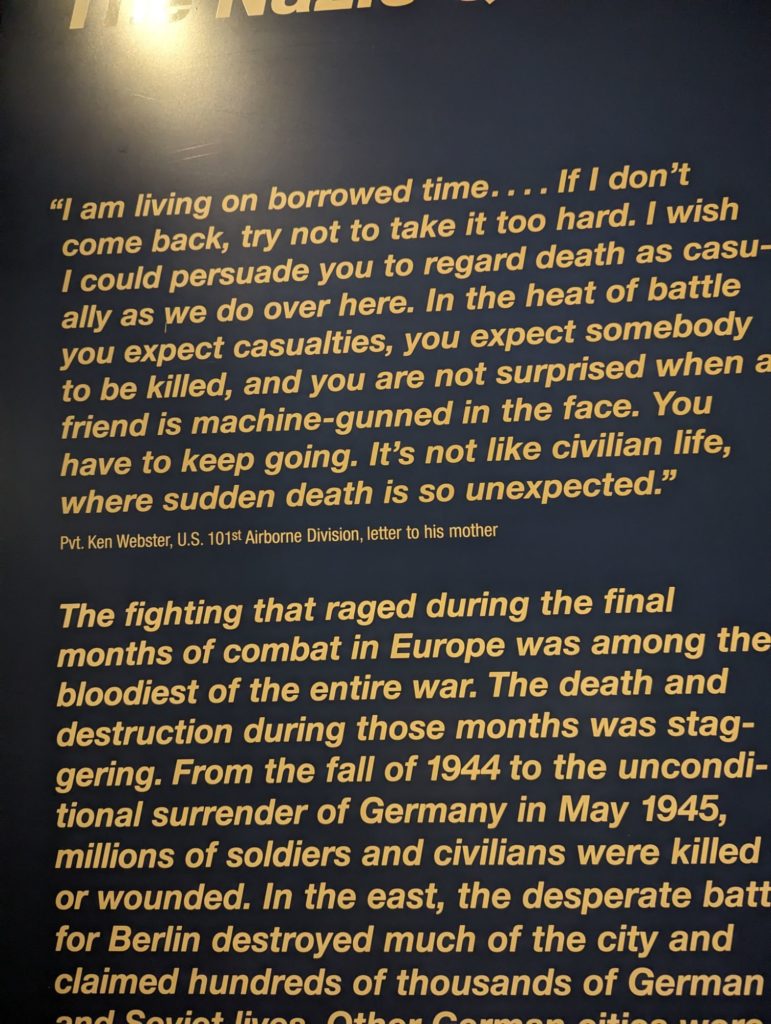
Next up were the European and Pacific front exhibits. The first thing I was struck by was how much attention had been paid to the physical space itself. Architectural support pillars were formed like trees, and the floors, walls, and ceiling of each section tried to appear like the natural environment of the area the exhibit was focused on. I was especially impressed by the European section’s representation of a snowy forest, and by the Pacific section’s tropical jungle.
Being so intentional with the space really increased the immersion, though with the obvious cost that changing the boundaries or focus of any given section incredibly difficult.
While i found this part of the museum interesting, it was also where I began to feel a certain disappointment. It almost certainly shouldn’t have come as a surprise, but the museum steered pretty hard away from anything that might be considered controversial. The nuclear attacks on Hiroshima and Nagasaki barely got mentioned, for instance, and the US internment of Japanese-descended citizens got barely a mention.
But the avoidance took on a weird aspect in sections. Avoiding controversial topics was disappointing, but not exactly surprising in hindsight. However, in the Pacific section, there was a display that went into extreme detail about the US firebombing campaign in Japan, comprehensively describing all 50+ cities bombed and the extent of destruction of the fires, but with no discussion of the horror of that level of destruction or any reference to regret in hindsight.
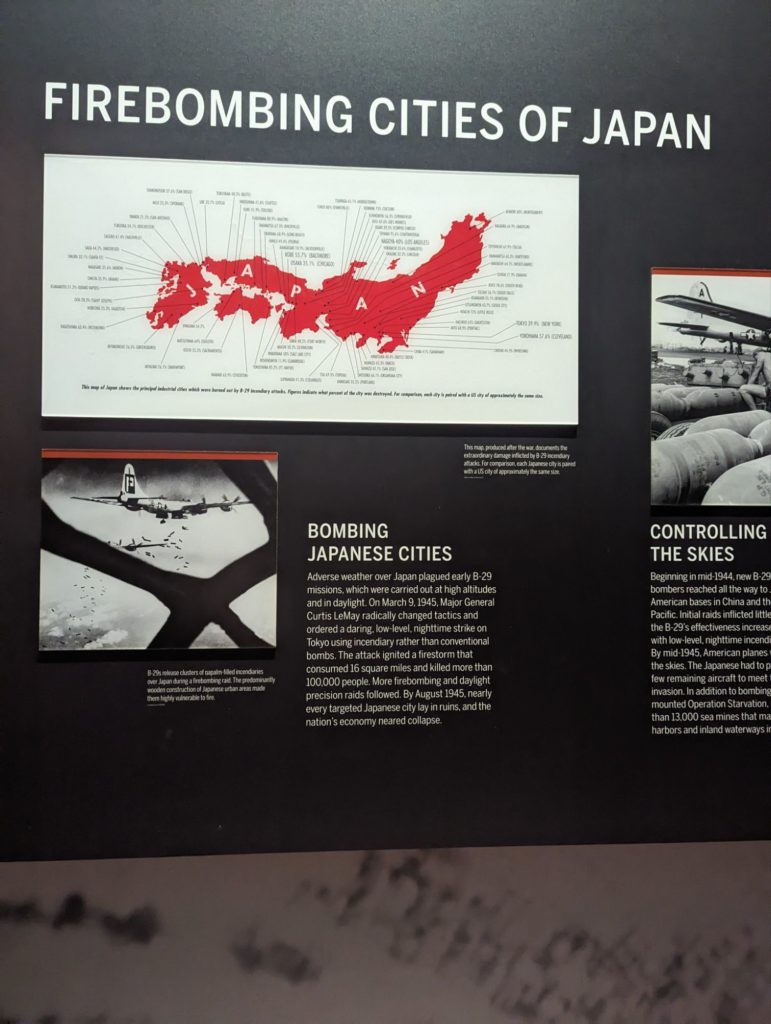
For someone who doesn’t know much about the US involvement in WWII, this all served as a reasonable walkthrough of the chronology of it all, but nothing deeper than that. Now, I’m not sure that this is actually a criticism. I’m pretty sure that the museum is working as intended: providing an overview of the US view of the world, and putting a human (and heroic) face on it all. Honoring the loss of American lives that took place is clearly an important part of the museum. I may prefer more complex discussion in museums, especially when they’re focused on topics I have at least a rudimentary existing understanding of, but I don’t think that that’s grounds for calling an exhibit weak or bad.
The final two sections of the museum were dedicated to the legacies of the war. One exhibit focused on the ideas of post war diplomacy and peacekeeping. It didn’t really get into the Cold War, but mostly stayed pretty surface level. A big part of this exhibit was focused on the “Four Freedoms” (of speech, of worship, from want, and from fear), and how the legacy of WWII was making the world better for everyone. It wasn’t bad, but it was hard to take too seriously given how bad a job it feels like we’ve done at upholding those values, both at the level of humanity and at the level of just the US.
The final aftermath section of the exhibit was, inevitably, focused on the Holocaust. I felt like it was pretty well done, continuing to use the architectural techniques of the rest of the museum to really add immersion (which was pretty haunting in some spaces). The big takeaway for me was, I suspect, not the intended one. They kept repeating this Eisenhower quote to try to reinforce the horror and evil of the Holocaust (and by extension, the Nazis): “We are told the American soldier does not know what he is fighting for. Now, at least he knows what he is fighting against.”
WWII has been a fact of my world so deep-seated that despite being reasonably familiar with quite a few aspects of the American participation in the war, hearing this quote made me realize I’d never really thought about the US motivation for getting involved. I imagine that a lot of people my age don’t give that question much thought because with hindsight we all know how literally evil the Nazi and Japanese Imperial regimes were. Not that the Allies didn’t engage in plenty of atrocities, but when the countries you fought against are permanently associated with Auschwitz and Nanking, it’s pretty easy to feel justified after the fact for almost any action you might take.
After a war, all sides seek to villainize those they fought, and WWII was no exception. The scope of the atrocities (on all sides, though don’t want to imply an equivalency, just remind that everyone is worse in war than we’d wish even if some are much worse) made this especially successful with WWII. Successful enough that i’d never really considered the motivations of the US in joining the war (despite being aware of the contention around the subject prior to Pearl Harbor).
Funny to think about the fact that despite my understanding of the systems that are designed to bypass our reasoning about the morality and reasons for war, those systems still worked just fine on me for 40 years.
Finally, and in a bit of a non sequitur, the final thing I saw was a temporary exhibit on the experience of women in the war effort. The exhibit was mostly focused on the various Women’s Auxiliary Corps, which was an area of history I was only vaguely familiar with. My biggest takeaways were two-fold.
First, and perhaps unsurprisingly, the expansion of responsibility and authority of women in society gave rise to exciting new forms of misogyny. One of the most striking to me was an illustration of women in uniform squatting on the floor around a game of dice, clearly showing how letting women out of the house led to their inevitable moral degeneration. It was amusing how silly it felt from a modern perspective.
One thing that the exhibit pointed out that hadn’t occurred to me was that the male members of the services were some of the biggest opponents to the inclusion of women. Naively, I would have thought they’d be the most interested in more help, but I suppose a lot of them found it emasculating that women were considered good enough to join them in the war.
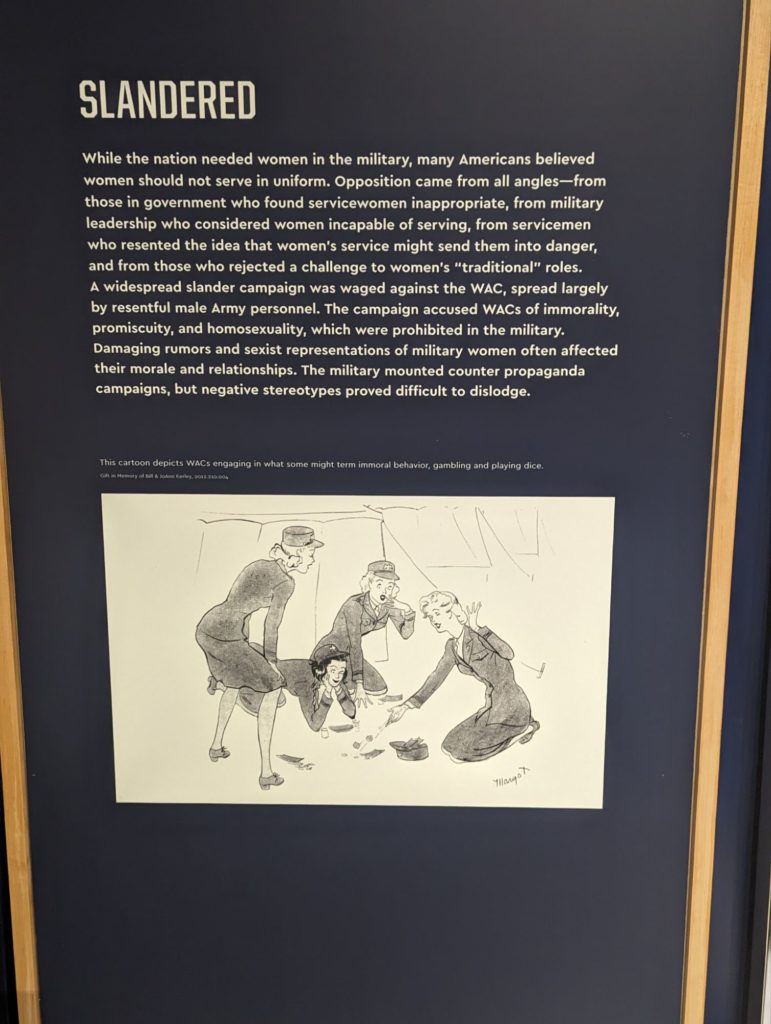
The second thing that caught my attention was a single item in the exhibit. A handmade dress that a nurse stationed in Europe made for a dance party that was constructed from parachute silk and a zipper from a pair of mens’ trousers. It occurs to me that the abundance of sewing skills, parachutes, and pants damage enough to be salvaged means that these may have been quite common. But I’ve never heard of them before, so I wonder if they’ve just never been given the attention they deserve, or if they were actually rare, or if few of them survived.
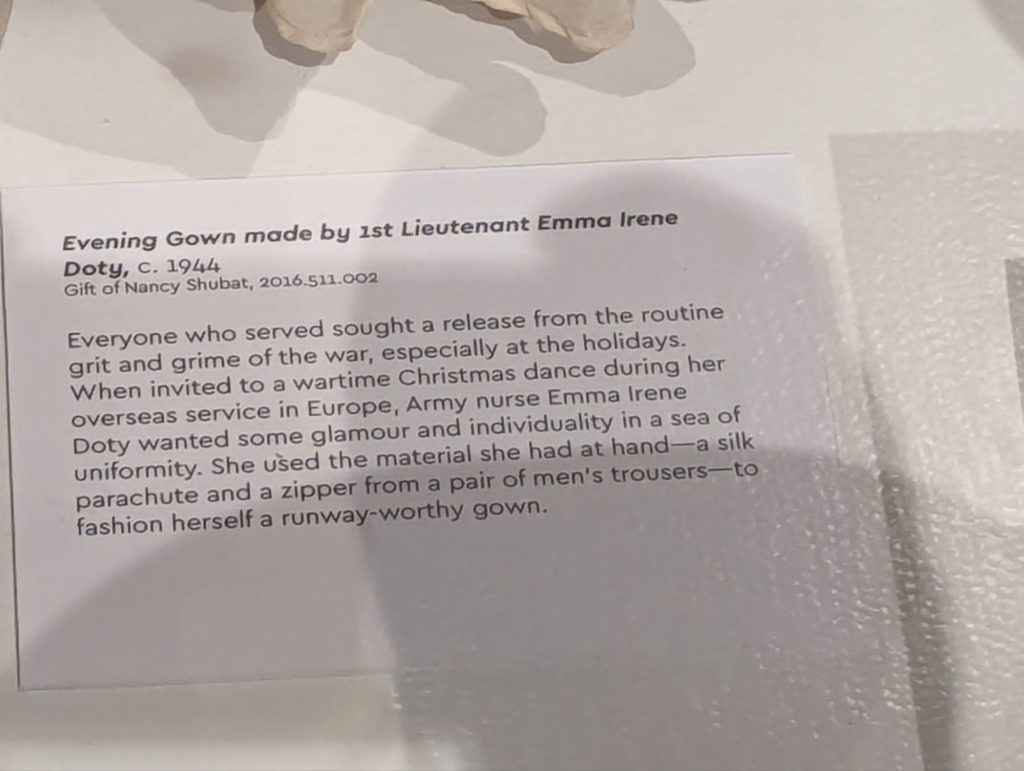
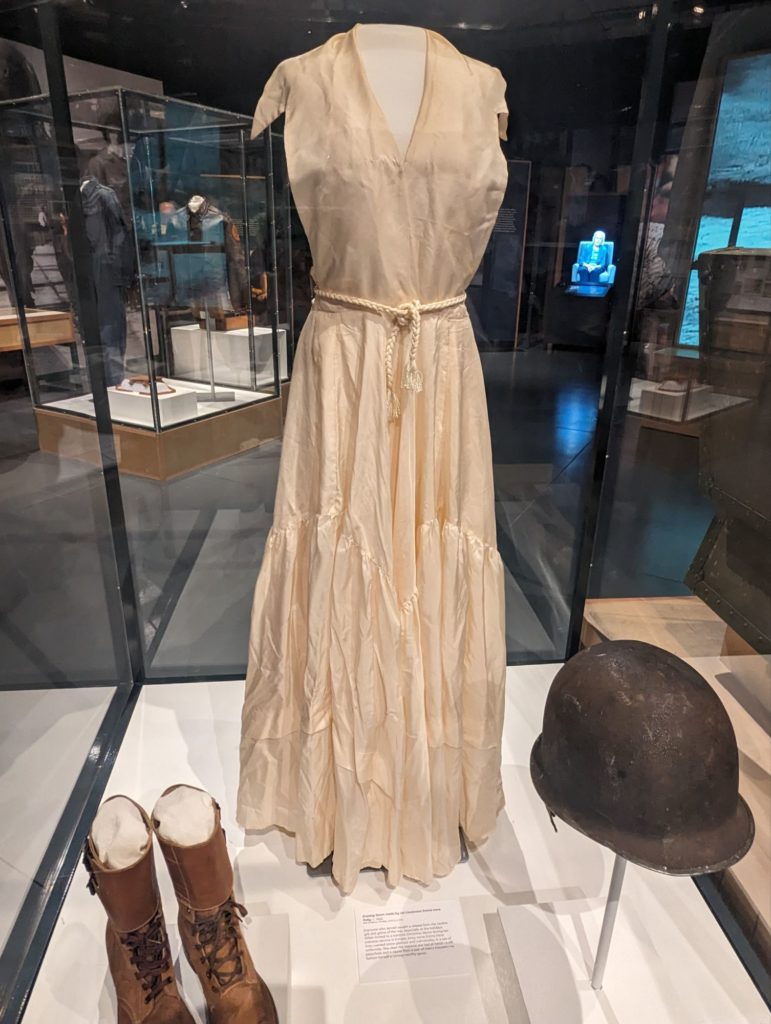
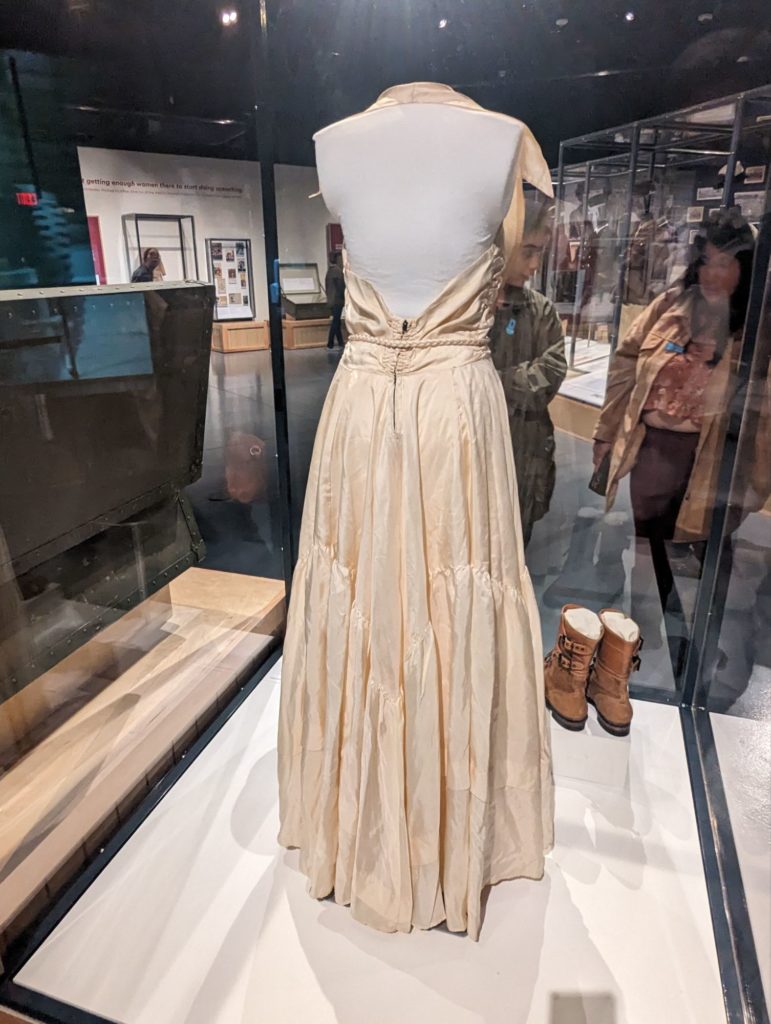
So that was my National WWII Museum experience. It made me think, even if it wasn’t something that, on the surface, I enjoyed most of. I don’t know if this post is a recommendation for or against you visiting yourself, but hopefully there’s something in here that makes it obvious to you if you’re ever in New Orleans.
Leave a Reply